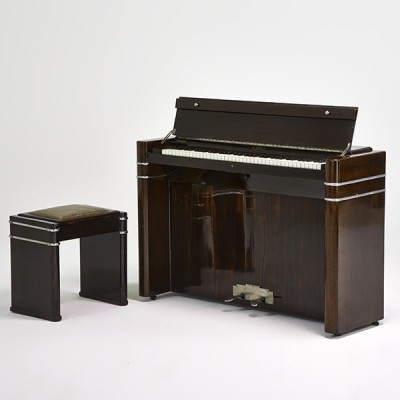Eavestaff Pianos

UK Piano Page

The Eavestaff piano company was established in 1823 at Finsbury Park, London. The Brasted brothers took them over in 1925. Brasted did make their own pianos, but they were not that well-known in their own right, so buying the Eavestaff name made good business sense. Brasted's had been established in 1870. In 1928 Brasted merged with Boyd Ltd., and in 1934 they introduced the Minipiano. Percy Brasted had discovered a miniature piano made by Messrs. Lundholm of Stockholm, from whom the Brasteds bought the rights. The piano was then made only in England, while Lundholm contracted to import them and receive a royalty on sales. The Eavestaff name was used for this piano.
Percy Brasted gave it the name Minipiano and it is sometimes claimed that it was his invention. However, it should be remembered that in the 1920s Hicks had contracted to make a small piano, strung at the back, of German design.
In the 1930s Eavestaff made small grands, 150 cm. in length, mainly in mahogany, some of them with quite ornate twin gate legs, as in the photo below.

Early models from 1934 had the wrest plank below the keyboard and the drop action at the rear, so that the hammers struck forwards towards the player. Wedging was unnecessary, as half the strings were monochords and the rest bichords. The wrest pins passed through the wrest plank and were double-ended to allow for stringing at the back. If a string has to be replaced, it will be appreciated that the coils have to be put on in the opposite direction and if the piano is chipped up from the back the pins are turned anti-clockwise to raise the pitch. Also, from this position, the bass will be on the right-hand side and the treble to the left. Later on, Jack Davis, who worked for Brasted's, designed a flanged iron frame to which the case would be built, enabling higher string tension and reducing the width by about eight inches. The Minipiano appeared in all kinds of finishes, and when coloured ones arrived in the Sheffield and Barnes Music shop in Oxford Street, London, the police were called in control the gazing crowds. At the end of the year sales topped 7,000 at 28-38 guineas each.
The braceless back was soon copied by other makers for small pianos. With the soundboard now forming the back of the piano, the action could be put in its traditional position, but of course, below the keys. Wires were attached to the backs of the keys to pull up the wippens and trichord stringing was re-introduced. Lastly, to achieve longer bass strings, a sort of triangular action was made, with the treble strike line being horizontal, but the bass section tapering down to the left. The Minipiano, and more particularly the early type, has often been criticised, but nevertheless, it should not be forgotten that it did much to maintain and even stimulate interest in an industry which was being hit by the gramophone and the radio. The name Eavestaff was used on the fall on the instrument. Americans usually know small uprights by the name spinet, which is neither accurate nor helpful.
In 1967, at the Frankfurt Fair in Germany, Eavestaff's Minitronic was shown for the first time. The short, horizontal strings were struck by small hammers in the ordinary way, but the tone, if you can call it that, was amplified through loudspeakers. There were two pedals, one of which was the sustaining pedal, and the other working like a swell, or, if you like, a nasty swelling. Each note had a single string and the bass strings did not have a steel core, just spiral wire. It had volume and tone controls, tremolo, and harpsichord stops.
At the end of the 1970s Eavestaff pianos were marketed by a new company formed by John Brasted. The pianos were to be made under licence by Kemble & Co. For some years previously, Eavestaff pianos were made at the Barratt & Robinson factory, Hermitage Road, Harringay. From the 1950s Eavestaff only made Minipianos, the best of which was the Royal model.
In the USA Hardman Peck & Co. made Eavestaff Minipianos under licence in the 50s and 60s. Eavestaff stopped making pianos in 1983. However, pianos with the Eavestaff name are made today by the Yantai Longfeng Piano Company, China. They are not Minipianos, but a standard upright piano. Brasted pianos have been made by them as well.
If you need to find out the age of your piano, or you can't find information about your piano make on one of our history pages, you could ask one of our users at our Piano Forum.



| c1950-135000 | c1958-172700 | c1964-185705 | c1970-187905 | c1976-171901 |
| c1953-141000 | c1959-174560 | c1965-183805 | c1971-140001 | c1977-176701 |
| c1954-150000 | c1960-176130 | c1966-185255 | c1972-147961 | c1978-40001 |
| c1955-161000 | c1961-177925 | c1967-185905 | c1973-148201 | c1979-40501 |
| c1956-166200 | c1962-180005 | c1968-196405 | c1974-152801 | c1980-41001 |
| c1957-169500 | c1963-181405 | c1969-187005 | c1975-166801 |
Barrie Heaton, FABPT, FIMIT, AEWVH (Dip.),CGLI (hon.) MMPTA (USA),
Visit my website Piano Tuning in Lancashire.
© copyright 2003.